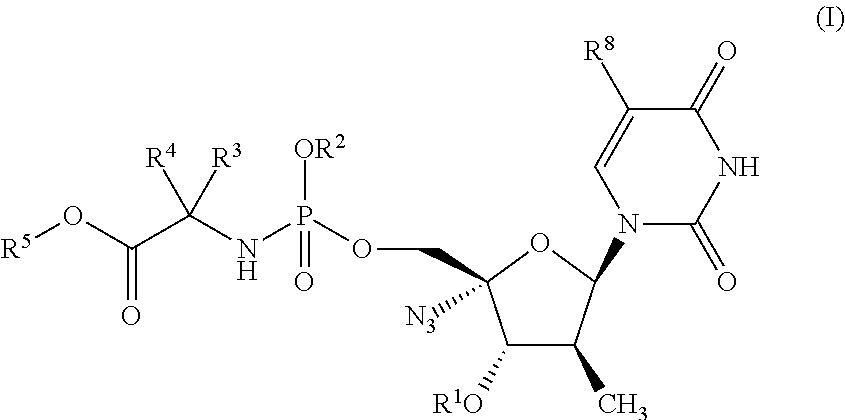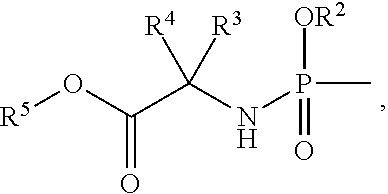Phosphoramidate derivatives of nucleosides
a technology of phosphoramidate and nucleoside, applied in the field of nucleoside compounds, can solve the problems of high rate of chronic infection, and high rate of chronic infection, and achieves the effects of improving the tolerance of patients, reducing the number of side effects of combination therapy, and improving the effect of cytotoxicity
- Summary
- Abstract
- Description
- Claims
- Application Information
AI Technical Summary
Problems solved by technology
Method used
Image
Examples
example 1
[0095]
[0096]3 g of 1-naphthol were loaded into a 3-neck flask and dissolved in Et2O (60 mL) under N2. To the solution was added POCl3 (1 eq.) and the resulting solution cooled to −78° C. To the cold solution was added dropwise (over approx. 15min.) Et3N (1 eq.). The reaction was allowed to reach room temperature overnight and then the white solid was filtered off, washed with Et2O while avoiding contact with moisture. The combined ether phases were concentrated in vacuum, the residue re-dissolved in CH2Cl2 (120 mL) under N2. To this solution was added L-alanine benzyl ester hydrochloride (1 eq.) and the mixture cooled to −78° C. To this was then added dropwise (over approx. 45 min) Et3N (1 eq.). The reaction was allowed to reach room temperature overnight. The solvent was removed in vacuum, avoiding contact with moisture and the residue passed through dry silica-gel eluting with EtOAc / heptane: 7 / 3. The fractions containing the product were concentrated in vacuum avoiding contact wit...
example 2
Preparation of Phosphorochloridates
[0097]
[0098]To a stirred solution of L-Alanine ethyl ester hydrochloride salt (5 g, 32.5 mmol, dried in vaccum for 48 h) in dichloromethane (50 mL) at approx -78° C. was dropwise added a solution of phenyl dichlorophosphate (5.7 g, 27 mmol, 4.05 ml) in dichloromethane (20 ml) over 5 minutes. To the resulting solution was added a solution of triethylamine (8.2 g, 81 mmol, 11.3 mL) in dichloromethane (20 mL) during 30 min. The obtained solid was slowly allowed to reach room temperature over 2 h, then the reaction mixture was applied directly onto column. Column chromatography (diam: 7 cm, SiO2: 100 g, Packing eluent: ethyl acetate in i-Hexane 20%) of the residue using ethyl acetate in i-Hexane (stepwise gradient 20-30%) gave separation from byproducts such as phosphordiamidates. Appropriate fractions (monitored by TLC: i-Hex-EtOAc 3:2, product comes first as baseline spots, followed by diamidates which migrates on the TLC plate) were concentrated giv...
example 3
[0100]Compounds I-1 to I-35 (see Table 1) were synthesized using a method as described herebelow. In most cases, after purification, the compounds were obtained as mixtures of diastereomers with a racemic configuration at the phosphorous atom. In case where the diastereomers could be separated, no assignment of absolute configuration was done.
[0101]
[0102]To a solution of 1-(5-Azido-4-hydroxy-5-hydroxymethyl-3-methyl-tetrahydro-furan-2-yl)-1H-pyrimidine-2,4-dione (0.88 g, 3.1 mmol) in dichloromethane (17 mL) and N-methyl-imidazole (0.76 g, 9.3 mmol, 0.74 ml) at approx −70° C. was dropwise added (2S)-ethyl 2-(chloro(phenoxy)phosphorylamino)propanoate (16 mL of a 0.25 M solution in dichloromethane) over 35 min while maintaining the temperature between −70 to −60° C. The reaction mixture was then slowly allowed to warm to 5-10° C. and was monitored by TLC (9:1 and 95:5 dichloromethane-methanol, UV detection). After a total of 130 min the reaction mixture was concentrated onto silica. Th...
PUM
| Property | Measurement | Unit |
|---|---|---|
| size | aaaaa | aaaaa |
| genetic heterogeneity | aaaaa | aaaaa |
| concentration | aaaaa | aaaaa |
Abstract
Description
Claims
Application Information
 Login to View More
Login to View More - R&D
- Intellectual Property
- Life Sciences
- Materials
- Tech Scout
- Unparalleled Data Quality
- Higher Quality Content
- 60% Fewer Hallucinations
Browse by: Latest US Patents, China's latest patents, Technical Efficacy Thesaurus, Application Domain, Technology Topic, Popular Technical Reports.
© 2025 PatSnap. All rights reserved.Legal|Privacy policy|Modern Slavery Act Transparency Statement|Sitemap|About US| Contact US: help@patsnap.com



